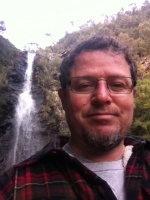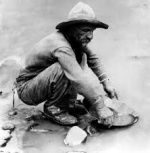Alluvial Gold Prospecting.
5 posters
Gold Detecting and Prospecting Forum :: General :: Prospecting Answers :: Sluicing, Panning, & History
Page 1 of 1
 Alluvial Gold Prospecting.
Alluvial Gold Prospecting.
Alluvial Gold Prospecting.
For the effective winning of alluvial gold you only need some very basic knowledge and a few simple tools to begin. As far as basic equipment goes, you will need a pick, a long handled round nose shovel, a small bottle in which to save your Gold and a prospecting dish (or Gold Pan).
After you become familiar with your pan (and I can’t stress this point enough) you must then become a proficient panner. The best, and most efficient way, to begin to learn this learning is to find and accompany an experienced person who can teach you on the spot. Once that proficiency, to separate the blacks sands from the Gold is learned, it is best used while still in the field, in order to reducing the weight of ‘things to be carried out’. This panning skill quickly progresses to eventually take very little time to complete.
In the course of your increasing experience you will soon find it helpful to construct a traditional sluice box or a “cradle” (a rocking sluice box). These can easily made, depending on your mechanical and ‘scrounging’ skills, at a cost of $100 or less.
When water is available (using a small water pump), hand shoveling directly into a sluice box enables a man to put through about 10 times more wash material in a day as through a “cradle”(having to both hand feed water to a rocking sluice box) and a hundred times (!) as much as he will treat in a dish. The dish is used for preliminary prospecting, to get indications of “colour”, and to wash the concentrates that collect in the riffles of the unit you are using. That final washing being done at the end of the “clean-up” process.
Alluvial prospecting is most rewarding activity, and great personal satisfaction can be gained from its pursuit. A few dollars worth of equipment, fuel for the water pump and a fortnight's rations (you were going to eat anyway – right?) and the returns, though smaller than from reef ore, are certainly attainable and thoroughly pleasurable in their outcome.
In fact, provided two men are working in a field which has gold bearing wash dirt, a supply of water for the pump, carefully constructed equipment, a knowledge of procedure, and the will to do a solid day’s work, there is little doubt that they could make a living on an alluvial field.
HOW TO SUCCEED.
At some time in the earth's history, alluvial gold washed down from its various sources and has deposited in the present beds of our rivers and creeks. This is where to start your hunt. The first step is to determine whether the creek or river holds any Gold, identify what types of mineral and soils are associated with the Gold and the richness of the Gold for that set of circumstances. This is very essence of finding a Gold rich lead within a river system.
A creek situation is a bit simpler, in that all you need do is trench across the narrow creek from the high water mark, across the streambed, to the opposite point on the other bank. Test panning as you go will give you the results you need to determine the actual richness of the stream. The daunting task, though, is when you are faced with vast sand or silt bars within a river system. Where to start on that effort?
The very first place, where all the written work tells you to begin, is at a rock bar. Of course, every one else over the past 160 odd years have also read those books as well.
Since Gold is one of the heaviest of minerals in the streambeds, it will generally gravitate, and be caught over time, in the very bottom of a streambed’s bedrock crevice. This is what you must attempt to find. It does not matter the quantity of Gold you actually find at this point, but rather, the exercise is to ascertain whether Gold does actually exist in this location. In addition, you will wish to take note of the associated indicator minerals that are found in your pans’ concentrates. Those indicator (or associated) minerals will take you to the Gold leads, within the river system, 90% of the time.
PERSEVERANCE IS ESSENTIAL.
One cannot lay down any hard and fast rules in prospecting for the deposits buried in river beds, but a careful prospector will take particular notice of where the stream has altered its course slightly, here and there, leaving the sand and gravel that once formed its original bed high and dry.
A wise prospector, in cases such as this, will generally sink holes to these gravels or until bedrock is reached. If the first hole is not successful he will usually sink successive holes in the direction towards the main channel. Here again the elements of luck and experience will play quite some part. The first one, two or three holes may prove profitless, but the fourth may produce sufficient Gold to make ones hopes "spring eternal”. In alluvial Gold-seeking, the rewards correspond remarkably to the intelligence and magnitude of the effort made.
It does not follow that a gully or river-bed is non-auriferous just because a few holes have been sunk in it without good results. That river bed cannot be said to have been properly tested until the deposits in its bed, have been thoroughly crossed from side to side and panned in all promising places. Quite frequently, too, the Gold occurs, not in the gully bed, or ‘gutter’, but in some deposit on one of the various banks’ high benches. You would be well advised to carry out your preliminary work quite thoroughly before finally abandoning any easily prospected locality as ‘worthless’, even should they have evidence of it having been tried and left by others in the past. In addition, do not be fooled into thinking that the first occurrence of Gold means to stop testing. To find the best Gold you must have other areas, showing Gold, to compare your results.
Many Thanks to KAEOJ & Murachu for assisting in the documents drafting.
I withhold permission for this article to be cut and pasted or duplicated onto any other web site. The reproduction of this account must include the
attribution of authorship and the associated copyright notice which follows the account. You may not modify, alter, add to, adapt, edit, abridge, condense or repackage this account without the written permission of the author.
© JB 9/3/2011

Photo © JB 9/3/2011
For the effective winning of alluvial gold you only need some very basic knowledge and a few simple tools to begin. As far as basic equipment goes, you will need a pick, a long handled round nose shovel, a small bottle in which to save your Gold and a prospecting dish (or Gold Pan).
After you become familiar with your pan (and I can’t stress this point enough) you must then become a proficient panner. The best, and most efficient way, to begin to learn this learning is to find and accompany an experienced person who can teach you on the spot. Once that proficiency, to separate the blacks sands from the Gold is learned, it is best used while still in the field, in order to reducing the weight of ‘things to be carried out’. This panning skill quickly progresses to eventually take very little time to complete.
In the course of your increasing experience you will soon find it helpful to construct a traditional sluice box or a “cradle” (a rocking sluice box). These can easily made, depending on your mechanical and ‘scrounging’ skills, at a cost of $100 or less.
When water is available (using a small water pump), hand shoveling directly into a sluice box enables a man to put through about 10 times more wash material in a day as through a “cradle”(having to both hand feed water to a rocking sluice box) and a hundred times (!) as much as he will treat in a dish. The dish is used for preliminary prospecting, to get indications of “colour”, and to wash the concentrates that collect in the riffles of the unit you are using. That final washing being done at the end of the “clean-up” process.
Alluvial prospecting is most rewarding activity, and great personal satisfaction can be gained from its pursuit. A few dollars worth of equipment, fuel for the water pump and a fortnight's rations (you were going to eat anyway – right?) and the returns, though smaller than from reef ore, are certainly attainable and thoroughly pleasurable in their outcome.
In fact, provided two men are working in a field which has gold bearing wash dirt, a supply of water for the pump, carefully constructed equipment, a knowledge of procedure, and the will to do a solid day’s work, there is little doubt that they could make a living on an alluvial field.
HOW TO SUCCEED.
At some time in the earth's history, alluvial gold washed down from its various sources and has deposited in the present beds of our rivers and creeks. This is where to start your hunt. The first step is to determine whether the creek or river holds any Gold, identify what types of mineral and soils are associated with the Gold and the richness of the Gold for that set of circumstances. This is very essence of finding a Gold rich lead within a river system.
A creek situation is a bit simpler, in that all you need do is trench across the narrow creek from the high water mark, across the streambed, to the opposite point on the other bank. Test panning as you go will give you the results you need to determine the actual richness of the stream. The daunting task, though, is when you are faced with vast sand or silt bars within a river system. Where to start on that effort?
The very first place, where all the written work tells you to begin, is at a rock bar. Of course, every one else over the past 160 odd years have also read those books as well.
Since Gold is one of the heaviest of minerals in the streambeds, it will generally gravitate, and be caught over time, in the very bottom of a streambed’s bedrock crevice. This is what you must attempt to find. It does not matter the quantity of Gold you actually find at this point, but rather, the exercise is to ascertain whether Gold does actually exist in this location. In addition, you will wish to take note of the associated indicator minerals that are found in your pans’ concentrates. Those indicator (or associated) minerals will take you to the Gold leads, within the river system, 90% of the time.
PERSEVERANCE IS ESSENTIAL.
One cannot lay down any hard and fast rules in prospecting for the deposits buried in river beds, but a careful prospector will take particular notice of where the stream has altered its course slightly, here and there, leaving the sand and gravel that once formed its original bed high and dry.
A wise prospector, in cases such as this, will generally sink holes to these gravels or until bedrock is reached. If the first hole is not successful he will usually sink successive holes in the direction towards the main channel. Here again the elements of luck and experience will play quite some part. The first one, two or three holes may prove profitless, but the fourth may produce sufficient Gold to make ones hopes "spring eternal”. In alluvial Gold-seeking, the rewards correspond remarkably to the intelligence and magnitude of the effort made.
It does not follow that a gully or river-bed is non-auriferous just because a few holes have been sunk in it without good results. That river bed cannot be said to have been properly tested until the deposits in its bed, have been thoroughly crossed from side to side and panned in all promising places. Quite frequently, too, the Gold occurs, not in the gully bed, or ‘gutter’, but in some deposit on one of the various banks’ high benches. You would be well advised to carry out your preliminary work quite thoroughly before finally abandoning any easily prospected locality as ‘worthless’, even should they have evidence of it having been tried and left by others in the past. In addition, do not be fooled into thinking that the first occurrence of Gold means to stop testing. To find the best Gold you must have other areas, showing Gold, to compare your results.
Many Thanks to KAEOJ & Murachu for assisting in the documents drafting.
I withhold permission for this article to be cut and pasted or duplicated onto any other web site. The reproduction of this account must include the
attribution of authorship and the associated copyright notice which follows the account. You may not modify, alter, add to, adapt, edit, abridge, condense or repackage this account without the written permission of the author.
© JB 9/3/2011

Photo © JB 9/3/2011
Guest- Guest
 Re: Alluvial Gold Prospecting.
Re: Alluvial Gold Prospecting.
By the way James 101, that is a very interesting read. I think it is a fantastic way of explaining to people that are new to the hobby (like me) how to get started.
Keep up the great work!
Nature Pete.


Keep up the great work!
Nature Pete.

Nature_Pete- Contributor Plus

- Number of posts : 255
Registration date : 2011-03-09
 Re: Alluvial Gold Prospecting.
Re: Alluvial Gold Prospecting.
Well written piece- similar in style to some articles I've read from goldrush times. I've tried my hand a couple of times and have yet to catch a glimmer of the yellow stuff- but I will perservere! I think I have to concentrate more on digging down to the bedrock before panning- as I guess there's no short cuts... When I finally get one little flake of gold I'll think about sluicing...
When you say trenching from one side of a small creek bed to the other- do you mean that literally? As in digging down to the bedrock from the high water mark on one side of the creek to the high water mark on the other?
When you say trenching from one side of a small creek bed to the other- do you mean that literally? As in digging down to the bedrock from the high water mark on one side of the creek to the high water mark on the other?


kilter- Contributor

- Number of posts : 54
Age : 54
Registration date : 2011-09-08
 Re: Alluvial Gold Prospecting.
Re: Alluvial Gold Prospecting.
kilter wrote:When you say trenching from one side of a small creek bed to the other- do you mean that literally? As in digging down to the bedrock from the high water mark on one side of the creek to the high water mark on the other?
I do indeed, you may only be looking for a run of 8 inches or so. and to find it you must dig. cheers
Guest- Guest
 Re: Alluvial Gold Prospecting.
Re: Alluvial Gold Prospecting.
Thanks james 101, kaeoj and murachu,
Great read and info. I have never panned but own one and had no luck with pan so far. I really want to get into some form of sluicing but have not known anybody to get help of. Watching utube of guys at it makes it look easy but reading comments on this forum it is obvious that there is a lot more to it and how units are set up than meets the eye. I believe if we try it we best be trying it the best possible way.
Prehaps that is why I just use the 4500, had lots of luck with that but know areas where if I had a dryblower would most certainly do very well.
In tassy here wet it the only way though.
Thanks travelergold
Great read and info. I have never panned but own one and had no luck with pan so far. I really want to get into some form of sluicing but have not known anybody to get help of. Watching utube of guys at it makes it look easy but reading comments on this forum it is obvious that there is a lot more to it and how units are set up than meets the eye. I believe if we try it we best be trying it the best possible way.
Prehaps that is why I just use the 4500, had lots of luck with that but know areas where if I had a dryblower would most certainly do very well.
In tassy here wet it the only way though.
Thanks travelergold
Guest- Guest
 Re: Alluvial Gold Prospecting.
Re: Alluvial Gold Prospecting.
travelergold wrote:Thanks james 101, kaeoj and murachu, Great read and info. I have never panned but own one and had no luck with pan so far. I really want to get into some form of sluicing but have not known anybody to get help of. Watching utube of guys at it makes it look easy but reading comments on this forum it is obvious that there is a lot more to it and how units are set up than meets the eye. I believe if we try it we best be trying it the best possible way.
Prehaps that is why I just use the 4500, had lots of luck with that but know areas where if I had a dryblower would most certainly do very well. In tassy here wet it the only way though. Thanks travelergold
Thanks T.G sluicing is a great way to get gold on a bad day I would be looking at a gram, on a good day I could be looking at ¼ of an ounce but there are a lot of days in between with varying averages.
The information we and others have posted on site is second to none if understood will assist a new slicer no ends. I see a lot of post from people just starting out, I read what they say and the advice given but mate in most cases I can also see their shot ducks even before they start. The best advice I can give to a person just starting and new to the game is to join a club or link up with an experienced prospector. Cheers mate and thank you. If I can help you please ask away and I will do my best to guide you in the right direction. But it is that time of year and may take me a bit to reply.
Guest- Guest
 Re: Alluvial Gold Prospecting.
Re: Alluvial Gold Prospecting.
To the writer of the article at the start of this james 101 i think (not sure you appear as guest on my screen) where are you from mate and is there any chance of heading out with you at some point i tried panning for my first time this long weekend found about 0.1 g panning (couldnt get my sluice to work effectively/ dont know how to use that properly yet) took all morning but i finally found a clay deposit on the side of a creek which is where i got the 0.1 g from took 3 buckets home so hopefully there is more in them (my hope of granduer where kinda shot down but way to into this to quit and the fact i found some on my own and on my first time has spurred me on and to find out more

Show Me The Gold- Contributor Plus

- Number of posts : 288
Age : 39
Registration date : 2012-07-23
 Re: Alluvial Gold Prospecting.
Re: Alluvial Gold Prospecting.
Hi show me the gold
Alas james no longer comes to this site so you wont get an answer to your question.
he lives in nsw but i have had the pleasure of meeting this guy here in victoria and he is a wizz at all this panning and sluicing stuff to a point that i now run on my own fairly sucsessfully.
2 top guys where lost to this forum , 1 being james and the other murachu.
their wealth of info will be missed from this forum
Rustydog
Alas james no longer comes to this site so you wont get an answer to your question.
he lives in nsw but i have had the pleasure of meeting this guy here in victoria and he is a wizz at all this panning and sluicing stuff to a point that i now run on my own fairly sucsessfully.
2 top guys where lost to this forum , 1 being james and the other murachu.
their wealth of info will be missed from this forum
Rustydog

Rustydog- Contributor Plus

- Number of posts : 299
Age : 48
Registration date : 2011-07-11
 Re: Alluvial Gold Prospecting.
Re: Alluvial Gold Prospecting.
Show Me The Gold wrote:and is there any chance of heading out with you at some point
I am sorry mate I use to take people out and train them but I don’t do that any more. Cheers James
Guest- Guest
 Re: Alluvial Gold Prospecting.
Re: Alluvial Gold Prospecting.
That's a gr8 shame Whiskers... Not enough of them good ol boys left on the field..
I remember a guy called nuggets in Ballarat about 20 plus years ago who taught me about panning and sluicing.
One day i cant wait to go back there too have a look at how it is nowadays.. specially now that huge mine is where i used to have a couple of spots.
I remember a guy called nuggets in Ballarat about 20 plus years ago who taught me about panning and sluicing.
One day i cant wait to go back there too have a look at how it is nowadays.. specially now that huge mine is where i used to have a couple of spots.

Grumpybunz- Contributor

- Number of posts : 56
Registration date : 2013-01-16
 Similar topics
Similar topics» Liteweight alluvial prospecting
» Rocky River Gold Fields and Mt Mutton Gully Alluvial Gold
» Alluvial Gold Recovery.
» Alluvial gold
» WASHING ALLUVIAL GOLD.
» Rocky River Gold Fields and Mt Mutton Gully Alluvial Gold
» Alluvial Gold Recovery.
» Alluvial gold
» WASHING ALLUVIAL GOLD.
Gold Detecting and Prospecting Forum :: General :: Prospecting Answers :: Sluicing, Panning, & History
Page 1 of 1
Permissions in this forum:
You cannot reply to topics in this forum